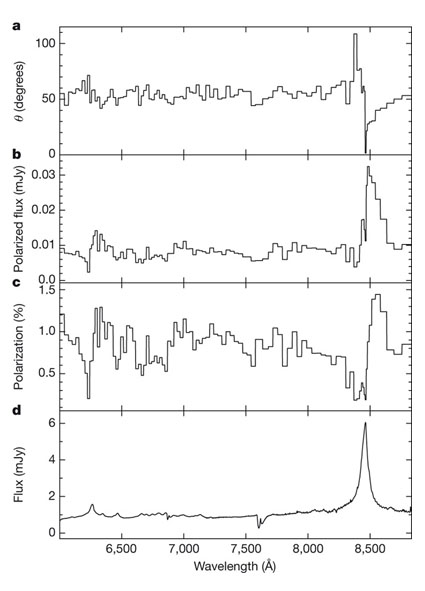Observational Evidence that Outflows from AGNs Originate as Disk Winds Rotating a Super-Massive Black Hole
ING web news release
3rd November, 2007
Astronomers from the Rochester Institute of Technology in New York and from the Centre for Astrophysics Research, Science & Technology Research Institute, University of Hertfordshire in UK have obtained
the first observational evidence that outflows from active galactic nuclei originate as winds from rotating accretion disks surrounding a super-massive black hole. Such evidence came from observations of quasar PG 1700+518 made by ISIS spectrograph in spectropolarimetric mode on the William Herschel Telescope.
Most galaxies undergo an active phase, during which a central super-massive black hole generates vast radiant luminosities through the gravitational accretion of gas. Winds launched
from a rotating accretion disk surrounding the black hole are thought to play a critial role, allowing the disk to shed angular momentum that would otherwise inhibit accretion.
Such winds are capable of depositing large amounts of mechanical energy in the host galaxy and its environs, profoundly affecting its formation and evolution, and perhaps regulating
the formation of large-scale cosmological structures in the early Universe. However, observational verification that AGN outflows originate as disk winds has proven elusive until now.
 |
The data were obtained using the William Herschel Telescope in conjunction with the ISIS spectrograph, at a spectral resolution of 3.4 Å.
The polarization data have been re-sampled into bins with an error of 0.1% in degree of polarization. a) The position angle of polarization, θ ;b) the polarized flux spectrum in mJy; c) the degree of polarization as a percentage; and d) the total flux spectrum in mJy.
Note the large change in polarization position angle across the broad Hα emission line, which reverses direction at the line peak.
In polarized flux, the broad emission line is redshifted with respect to the wavelength of the peak in total flux. Adapted by permission from Macmillan Publishers Ltd: Nature (S. Young et al., 450, 74), copyright 2007.
|
More information:
- RIT Study Confirms Supermassive Black Holes Produce Powerful Galaxy-Shaping Winds, RIT press release, 31st October, 2007.
Available versions: HTML | HTML local copy.
- S. Young, D. J. Axon, A. Robinson, J. H. Hough & J. E. Smith,
2007, The rotating wind of the quasar PG 1700+518, Nature, 450, 74.
|
|



